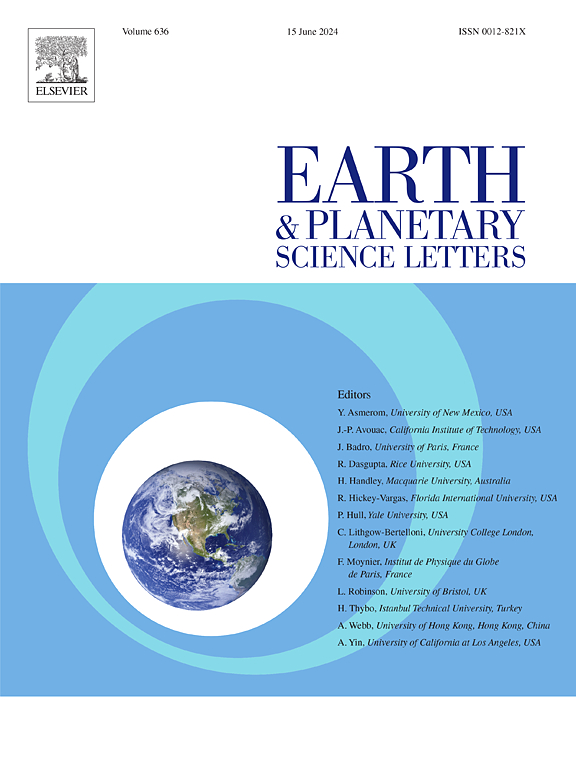白垩纪以来东亚地幔深层碳汇及其对大气CO2减少的影响
IF 4.8
1区 地球科学
Q1 GEOCHEMISTRY & GEOPHYSICS
引用次数: 0
摘要
早白垩世以来,西太平洋板块向东亚地幔深处俯冲,最终停滞在地幔过渡带(410-660 km)内。本文首次对与太平洋板块有关的东亚深层俯冲碳通量进行了定量估计,并评估了其对白垩纪以来大气CO2水平(pCO2)的影响。对分布广泛的东亚洲际玄武岩(EAIBs;N = 399),起源于停滞的西太平洋板块上方上地幔的部分熔融。通过熔体CO2脱气校正和“熔融-混合”模型,我们发现EAIBs的形成涉及硅酸盐熔体和富碳熔体之间普遍存在的岩浆混合。因此,估计EAIBs地幔源的碳含量出乎意料地高(297±118 μg/g);1σ),约为对流地幔平均碳含量(110±40 μg/g)的3倍,这主要是由于西太平洋板块的俯冲碳输入所致。基于古地理重建模型,我们发现两个俯冲碳流入地幔过渡带的高峰时期引发了东亚深层碳汇。在碳消减高峰和大范围喷发之间有大约26 Ma的间隙。这一差距表明,由于地幔碳排放效率低下,东亚深处的碳汇可能对白垩纪以来大气二氧化碳分压的下降做出了重大贡献。本文章由计算机程序翻译,如有差异,请以英文原文为准。
Deep carbon sink in the East Asian mantle and its impact on atmospheric CO2 drawdown since the Cretaceous
The western Pacific oceanic slab has been deeply subducted into the mantle beneath East Asia since the early Cretaceous, eventually stagnating within the mantle transition zone (410–660 km). Here we present the first quantitative estimate of the flux of deeply subducted carbon beneath East Asia related to the Pacific slab and evaluate its impact on atmospheric CO2 levels (pCO2) since the Cretaceous. We compiled chemical and zinc isotopic data for the widely distributed East Asian intercontinental basalts (EAIBs; N = 399), which originated from partial melting of the upper mantle above the stagnated western Pacific slab. By using a melt CO2 degassing correction and a "melting-mixing" model, we show that the formation of EAIBs involved ubiquitous magma mixing between silicate melts and carbon-rich melts. Consequently, the mantle source of EAIBs is estimated to have an unexpectedly high carbon content (297 ± 118 μg/g; 1σ), about three times the average carbon in the convecting mantle (110 ± 40 μg/g), primarily due to subducting carbon input from the western Pacific slab. Based on paleogeographic reconstruction models, we show that two peak periods of subducting carbon influx into the mantle transition zone sparked the deep carbon sink beneath East Asia. There is a gap of approximately 26 Ma between peak carbon subduction and widespread EAIB eruptions. This gap suggests that deep carbon sink beneath East Asia, due to inefficient mantle carbon outgassing, may have significantly contributed to the drawdown of atmospheric pCO2 since the Cretaceous.
求助全文
通过发布文献求助,成功后即可免费获取论文全文。
去求助
来源期刊

Earth and Planetary Science Letters
地学-地球化学与地球物理
CiteScore
10.30
自引率
5.70%
发文量
475
审稿时长
2.8 months
期刊介绍:
Earth and Planetary Science Letters (EPSL) is a leading journal for researchers across the entire Earth and planetary sciences community. It publishes concise, exciting, high-impact articles ("Letters") of broad interest. Its focus is on physical and chemical processes, the evolution and general properties of the Earth and planets - from their deep interiors to their atmospheres. EPSL also includes a Frontiers section, featuring invited high-profile synthesis articles by leading experts on timely topics to bring cutting-edge research to the wider community.
 求助内容:
求助内容: 应助结果提醒方式:
应助结果提醒方式:


